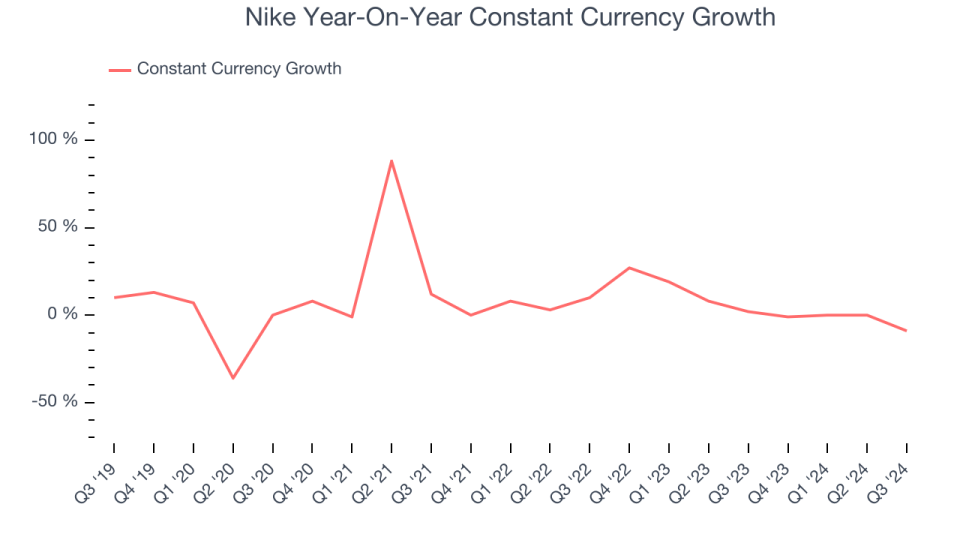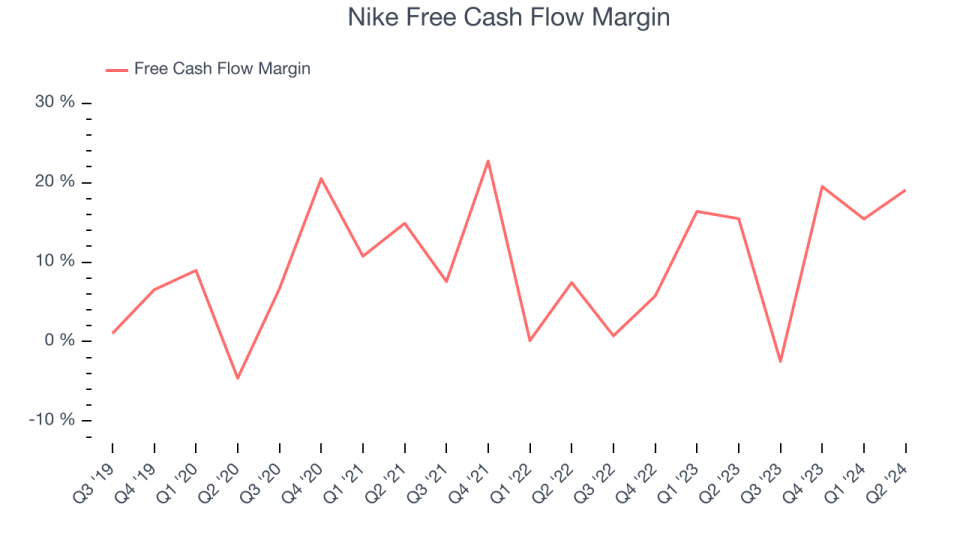Nike’s (NYSE:NKE) Q3 Earnings Results: Revenue In Line With Expectations

Athletic apparel brand Nike (NYSE:NKE) met Wall Street’s revenue expectations in Q3 CY2024, but sales fell 10.4% year on year to $11.59 billion. Its GAAP profit of $0.70 per share was 34.9% above analysts’ consensus estimates.
Is now the time to buy Nike? Find out in our full research report.
Nike (NKE) Q3 CY2024 Highlights:
Revenue: $11.59 billion vs analyst estimates of $11.65 billion (in line)
EPS: $0.70 vs analyst estimates of $0.52 (34.9% beat)
Gross Margin (GAAP): 45.4%, up from 44.2% in the same quarter last year
Constant Currency Revenue fell 9% year on year(compared to 2% in the same quarter last year)
Market Capitalization: $132.5 billion
Company Overview
Originally selling Japanese Onitsuka Tiger sneakers as Blue Ribbon Sports, Nike (NYSE:NKE) is a global titan in athletic footwear, apparel, equipment, and accessories.
Footwear
Before the advent of the internet, styles changed, but consumers mainly bought shoes by visiting local brick-and-mortar shoe, department, and specialty stores. Today, not only do styles change more frequently as fads travel through social media and the internet but consumers are also shifting the way they buy their goods, favoring omnichannel and e-commerce experiences. Some footwear companies have made concerted efforts to adapt while those who are slower to move may fall behind.
Sales Growth

A company’s long-term performance can indicate its business quality. Any business can put up a good quarter or two, but many enduring ones tend to grow for years. Over the last five years, Nike grew its sales at a sluggish 4.7% compounded annual growth rate. This shows it failed to expand in any major way and is a rough starting point for our analysis.
Long-term growth is the most important, but within consumer discretionary, product cycles are short and revenue can be hit-driven due to rapidly changing trends and consumer preferences. Nike’s recent history shows its demand slowed as its annualized revenue growth of 3% over the last two years is below its five-year trend.

We can better understand the company’s sales dynamics by analyzing its constant currency revenue, which exclude currency movements that are outside the company’s control and not indicative of demand. Over the last two years, its constant currency sales averaged 5.8% year-on-year growth. Because this number is better than its normal revenue growth, we can see that foreign exchange rates have been a headwind for Nike.
This quarter, Nike reported a rather uninspiring 10.4% year-on-year revenue decline to $11.59 billion of revenue, in line with Wall Street’s estimates. Looking ahead, Wall Street expects revenue to decline 1.4% over the next 12 months, a deceleration versus the last two years.
Unless you’ve been living under a rock, it should be obvious by now that generative AI is going to have a huge impact on how large corporations do business. While Nvidia and AMD are trading close to all-time highs, we prefer a lesser-known (but still profitable) semiconductor stock benefitting from the rise of AI. Click here to access our free report on our favorite semiconductor growth story.
Cash Is King
Although earnings are undoubtedly valuable for assessing company performance, we believe cash is king because you can’t use accounting profits to pay the bills.
Nike has shown decent cash profitability, giving it some flexibility to reinvest or return capital to investors. The company’s free cash flow margin averaged 12.7% over the last two years, slightly better than the broader consumer discretionary sector.

Key Takeaways from Nike’s Q3 Results
We were impressed by how significantly Nike blew past analysts’ EPS expectations this quarter. On the other hand, its constant currency revenue declined 9% and unfortunately missed. With the stock up 10% over the last month due to the applauded appointment of once-intern now CEO Elliott Hill, the market seemed to return to the reality that Nike is still struggling to reignite sales growth. The stock traded down 1.7% to $87.65 immediately following the results.
So should you invest in Nike right now?The latest quarter does matter, but not nearly as much as longer-term fundamentals and valuation, when deciding if the stock is a buy.We cover that in our actionable full research report which you can read here, it’s free.